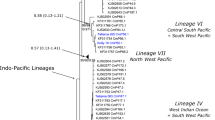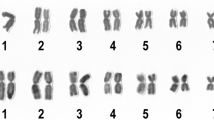Abstract
Three rare geoemydid turtles described from Chinese trade specimens in the early 1990s, Ocadia glyphistoma, O. philippeni, and Sacalia pseudocellata, are suspected to be hybrids because they are known only from their original descriptions and because they have morphologies intermediate between other, better-known species. We cloned the alleles of a bi-parentally inherited nuclear intron from samples of these three species. The two aligned parental alleles of O. glyphistoma, O. philippeni, and S. pseudocellata have 5–11.5 times more heterozygous positions than do 13 other geoemydid species. Phylogenetic analysis shows that the two alleles from each turtle are strongly paraphyletic, but correctly match sequences of other species that were hypothesized from morphology to be their parental species. We conclude that these rare turtles represent recent hybrids rather than valid species. Specifically, “O. glyphistoma” is a hybrid of Mauremys sinensis and M.␣cf. annamensis, “O.␣philippeni” is a hybrid of M. sinensis and Cuora trifasciata, and “S. pseudocellata” is a hybrid of C. trifasciata and S. quadriocellata. Conservation resources are better directed toward finding and protecting populations of other rare Southeast Asian turtles that do represent distinct evolutionary lineages.
Similar content being viewed by others
References
Buskirk JR, Parham JF, Feldman CR (2005) On the hybridisation between two distantly related Asian turtles (Testudines: Sacalia × Mauremys). Salamandra 41:21–26
Dalton R (2003) Mock turtles. Nature 423:219–220
de Bruin, RWF, Artner HG (1999) On the turtles of Hainan Island, southern China. Chelonian Conserv Biol 3:479–486
Feldman CR, Parham JF (2004) Molecular systematics of the Old World stripe-necked turtles (Testudines: Mauremys). Asiat Herpetol Res 10:28–37
Felsenstein J (1985) Confidence limits on phylogenies: an approach using the bootstrap. Evolution 39:783–791
Fujita MK, Engstrom TN, Starkey DE, Shaffer HB (2004) Turtle phylogeny: insights from a novel nuclear intron. Mol Phylogenet Evol 31:1031–1040
IUCN (2004) Red list of threatened species. Available from http://www.redlist.org (downloaded 28 January 2006)
Iverson JB (1992) A revised checklist with distribution maps of the turtles of the world. Green Nature Books, Homestead, Florida, USA
Iverson JB, McCord WP (1992) A new Chinese eyed turtle of the genus Sacalia (Batagurinae: Testudines). Proc Biol Soc Wash 105:426–432
Lau M, Shi H (2000) Conservation and trade of terrestrial and freshwater turtles and tortoises in the People’s Republic of China. In: van Dijk PP, Stuart BL, Rhodin AGJ (eds) Asian turtle trade: Proceedings of a workshop on conservation and trade of freshwater turtles and tortoises in Asia. Chelonian Research Monographs No. 2. Chelonian Research Foundation, Lunenburg Massachusetts USA, pp 30–38
McCord WP, Iverson JB (1992) A new species of Ocadia (Testudines: Bataguridae) from Hainan Island, China. Proc Biol Soc Wash 105:13–18
McCord WP, Iverson JB (1994) A new species of Ocadia (Testudines: Bataguridae) from southwestern China. Proc Biol Soc Wash 107:52–59
Parham JF, Li D (1999) A new locality for Cuora pani Song 1984 with comments on its known range. Asiat Herpetol Res 8:111–113
Parham JF, Shi H (2001) The discovery of Mauremys iversoni-like turtles at a turtle farm in Hainan Province, China: the counterfeit golden coin. Asiat Herpetol Res 9:71–76
Parham JF, Simison WB, Kozak KH, Feldman CR, Shi H (2001) New Chinese turtles: endangered or invalid? A reassessment of two species using mitochondrial DNA, allozyme electrophoresis and known locality specimens. Anim Conserv 4:357–367
Parham JF, Stuart BL, Bour R, Fritz U (2004) Evolutionary distinctiveness of the extinct Yunnan box turtle (Cuora yunnanensis) revealed by DNA from an old museum specimen. Proc R Soc Lond B (Biol Lett Suppl) 271:S391–S394
Posada D, Crandall KA (1998) Modeltest: testing the model of DNA substitution. Bioinformatics 14:817–818
Shi H, Parham JF (2001) Preliminary observations of a large turtle farm in Hainan Province, People’s Republic of China. Turt Tort Newsl 3:4–6
Shi H, Fan Z, Yin F., Yuan Z (2004) New data on the trade and captive breeding of turtles in Guangxi Province, South China. Asiat Herpetol Res 10:126–128
Shi H, Parham JF, Simison WB, Wang J, Gong S, Fu B (2005) A report on the hybridization between two species of threatened Asian box turtles (Testudines: Cuora) in the wild on Hainan Island (China) with comments on the␣origin of ‘serrata’-like turtles. Amphibia-Reptilia 26:377–381
Shimodaira H, Hasegawa M (1999) Multiple comparisons of log-likelihoods with applications to phylogenetic inference. Mol Biol Evol 16:1114–1116
Spinks PQ, Shaffer HB, Iverson JB, McCord WP (2004) Phylogenetic hypotheses for the turtle family Geoemydidae. Mol Phylogenet Evol 32:164–182
Stuart BL, Parham JF (2004) Molecular phylogeny of the critically endangered Indochinese box turtle (Cuora galbinifrons). Mol Phylogenet Evol 31:164–177
Stuart BL, Thorbjarnarson J (2003) Biological prioritization of Asian countries for turtle conservation. Chel Conserv Biol 4:642–647
Swofford DL (2002) PAUP*: Phylogenetic Analysis Using Parsimony *(and Other Methods), Version 4.0b10. Sinauer Associates, Sunderland, Massachusetts, USA
van Dijk PP, Stuart BL, Rhodin AGJ (eds) (2000) Asian turtle trade: Proceedings of a workshop on conservation and trade of freshwater turtles and tortoises in Asia. Chelonian Research Monographs No. 2. Chelonian Research Foundation, Lunenburg, Massachusetts, USA
Wink M, Guicking D, Fritz U (2001) Molecular evidence for hybrid origin of Mauremys iversoni Pritchard et McCord, 1991, and Mauremys pritchardi McCord, 1997 (Reptilia: Testudines: Bataguridae). Zool Abh Mus Tierkd Dresden 51:41–49
Acknowledgements
Philip Q. Spinks and H. Bradley Shaffer of the University of California, Davis made this study possible by loaning blood samples of O. glyphistoma, O. philippeni, and S. pseudocellata. Robert W. Murphy of the Royal Ontario Museum, and Uwe Fritz of the Staatliches Museum für Tierkunde, Dresden loaned tissue samples of additional taxa. Harold Voris, Alan Resetar, and Jamie Ladonski facilitated the use of tissues deposited at the Field Museum. Sequencing was conducted in the The Field Museum’s Pritzker Laboratory for Molecular Systematics and Evolution operated with support from the Pritzker Foundation. Erin Sackett assisted with cloning. Richard Banks and Roy W. McDiarmid granted permission to reproduce figures from the Proceedings of the Biological Society of Washington. This research is LBNL-59607 and was performed under the auspices of the U.S. Department of Energy’s Office of Biological and Environmental Research and by the University of California, Lawrence Berkeley National Laboratory under Contract No. DE-AC02-05CH11231. This research is also University of California Museum of Paleontology Contribution # 1920. This research was supported by a National Science Foundation postdoctoral fellowship to JFP. Philip Q. Spinks and two anonymous reviewers critiqued the manuscript.
Author information
Authors and Affiliations
Corresponding author
Rights and permissions
About this article
Cite this article
Stuart, B.L., Parham, J.F. Recent hybrid origin of three rare Chinese turtles. Conserv Genet 8, 169–175 (2007). https://doi.org/10.1007/s10592-006-9159-0
Received:
Accepted:
Published:
Issue Date:
DOI: https://doi.org/10.1007/s10592-006-9159-0




